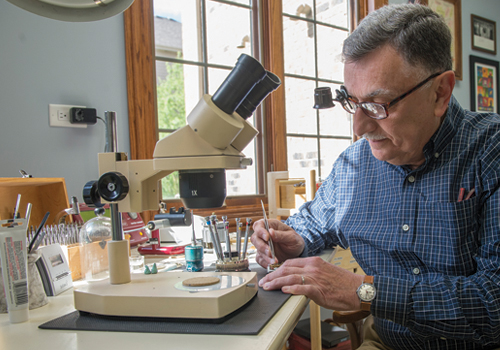2017 Member Snap Shots
Anthony Maoloni
Keeping time with Anthony Maoloni
Adults take painstaking efforts to get kids interested in a subject. They’ll pay a bundle for music lessons, spend time carting kids back and forth from athletic practices, or buy elaborate starter kits for everything from magic shows to stamp collecting, all in the hopes of getting kids interested in something.
But there is no telling what small and seemingly insignificant act can influence the mind of a child, and ignite an everlasting passion.
A trip to the zoo might spark a lifelong interest in creatures of all sorts and shapes; a walk past a construction site might ingrain a love of architecture and construction.
Such a pedestrian moment had just that affect on a 10-year-old Anthony Maoloni.
Well before he graduated from Loyola University College of Dental Surgery in 1977 and became a successful orthodontist with offices in Flossmoor and New Lenox, Dr. Maoloni and his brother spent an afternoon visiting an aunt.
The weather outside was miserable, and his aunt looked for a way to keep the youngsters occupied during a rainy afternoon.
So she dragged out a box filled with old alarm clocks and let them go at it.
Dr. Maoloni’s brother could have cared less about the clocks. His interest, it seems, was more geared toward the cultural aspects of life and he became enthralled with movies, especially old-time silent varieties. Dr. Maoloni said his brother has an encyclopedic knowledge of all things cinema.
But little Anthony Maoloni couldn’t get enough of the clocks. He spent hours taking them apart and trying to get them to run again.
He was hooked.
From that time on he developed a passion for the world of timepieces from simple wristwatches to giant tower clocks that display the time for all in a city to see.
It takes two to three hours for him to work on a watch project, he said. Friends who know of his hobby will bring in a watch that needs repair. Plus, he goes to flea markets and swap meets through the National Association of Watch and Clock Collectors looking for treasures.
“I have a collection of them,” he said of fine time pieces, “I take them and try and repair them.”
But it is an instrument that had a reputation for being an everyman watch that intrigues him the most.
“I’m particularly fond of Timex watches,” he said. “It has a very interesting history.”
Actually, the wristwatch only became popular about a century ago with the first being made in 1868 for a Hungarian countess as a ladies accessory. The Timex brand evolved from the Waterbury Clock Co., which started in 1854.
The company’s history is intertwined with two world wars, sandwiching a cartoon mouse of certain fame in the middle, Dr. Maoloni explained. It is the intersection of history and old-fashioned American quality and simplicity that is admirable about the Timex, he declared.
During World War I the company reworked a ladies pocket watch into a wristwatch so soldiers didn’t have to pull out a pocket watch. And then, during the Great Depression, the company turned to Mickey Mouse to save the day, producing the famous character watch that sold for $1.50 and kept the company for going bankrupt.
During World War II two Norwegian immigrants fled their homeland after the German invasion, bought the Waterbury company and used the technology to manufacture bomb and artillery fuses that were simple but accurate, Dr. Maoloni recounted.
After the war the company decided to convert its fuse building Timex plant to manufacture inexpensive yet reliable wristwatches.
These were mass-produced, Dr. Maoloni said, but were a testament to American know-how and industry.
“The design of the mechanical watch was not a thing of beauty,” he said, “but they worked, and it was fantastic to see it stamped on the back that they were made in the U.S.”
Timex watches were made with hard alloy bearings and were virtually indescructable whereas high-end watches made using synthetic sapphire jewels were more delicate although they are a more smooth running instrument.,
But there is a trade-off — an increased fragility and a hard knock could easily crack a jewel, Dr. Moloni said.
Timex was famously advertised on TV with newsman John Cameron Swazye putting them through various torture tests and exclaiming, “It takes a licking and keeps on ticking!”
Dr. Maoloni said he works on jeweled watches brought to him by friends.
He said his training as a dentist has helped with his hobby.
“The skills I learned in dentistry has helped be with the dexterity to handle very, very tiny parts,” he said.
He’ll even take a crack at fixing a battery powered quartz watch, which has the advantage over a mechanical watch of being highly accurate yet durable.
Dr. Maoloni said while he admires the technical aspects of a quartz watch, and some of the newer watches that run on solar panels and can turn themselves off when you sleep and jump to the correct time when you wake up, they just don’t have the same allure as a Timex.
“A mechanical watch has a soul, it was crafted and assembled by a human being,” Dr. Maoloni said. “Sure, quartz watches might designed by a human, but they are machine made and assembled.”


Leave a comment